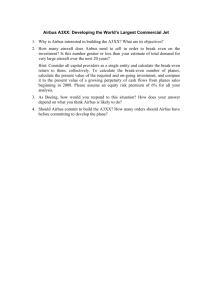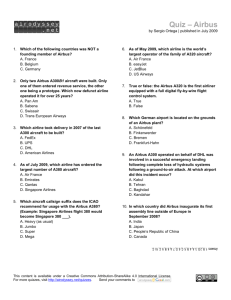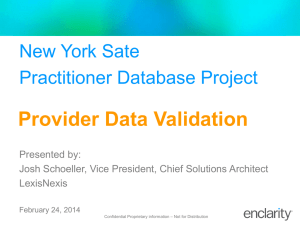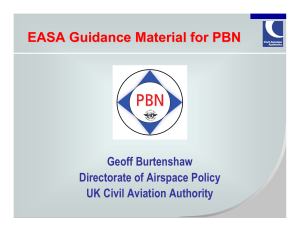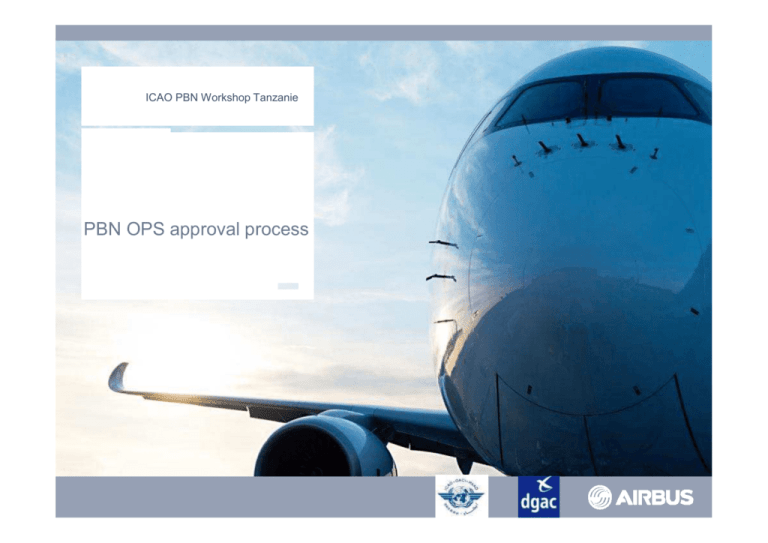
ICAO PBN Workshop Tanzanie
PBN OPS approval process
PBN OPS approval Process
• Introduction to Doc 9997 published by ICAO
• PBN nav spec
• PBN application
• Airworthiness and Ops approval process
• OPS Approval Process
© AIRBUS Operations S.A.S. All rights reserved. Confidential and proprietary document.
PBN OPS approval Process
• Doc 9997 published by ICAO
• Provide guidance on the operational
approval process for PBN
• introduction on PBN principles
• Certification and Operational
approval
• Operational approval guideline
• Navigation specifications
© AIRBUS Operations S.A.S. All rights reserved. Confidential and proprietary document.
PBN – navigation specifications
• Navigation specifications published to date
© AIRBUS Operations S.A.S. All rights reserved. Confidential and proprietary document.
PBN applications
RNAV 1
RNAV 5
RNAV 10
RNP 1
RNP APCH
The navigation application uses a navigation specification and the associated
NAVAID infrastructure that allows an aircraft to fly in a designated airspace,
on a route or on a procedure with the required performance level.
© AIRBUS Operations S.A.S. All rights reserved. Confidential and proprietary document.
Airworthiness and Ops Approval
The PBN concept requires that
1. The aircraft meets a certain level of performance described in the
navigation specification
•
the performance of the on-board system in terms of accuracy,
continuity and integrity
•
the functionalities of the system
2. The operator complies with the operational criteria defined in the
PBN navigation specification.
© AIRBUS Operations S.A.S. All rights reserved. Confidential and proprietary document.
Airworthiness and Ops Approval
• The airworthiness certification process ensures that the aircraft complies
with certain standards (e.g AC, AMC, CS,…) which guarantees that the
level of performance and the functionalities required by the PBN
navigation specification are met.
• Operators (Airline) has to demonstrate to their supervisor inspector that
the Aircraft is eligible for the PBN operation.
• Eligibility is determined by checking that the adequate airworthiness
certification has been done.
© AIRBUS Operations S.A.S. All rights reserved. Confidential and proprietary document.
Applicable standards
• FAA AC (Advisory Circular)
• AC 20-xx for Airworthiness criteria (avionics function)
• AC 90-xx for OPS approval
• EASA AMC 20- xx for PBN are divided into 3 parts :
• Context - Assumptions
• Airworthiness criteria (performance, functions, maintenance)
• OPS approval
• EASA next step : AMC 20-xx related to PBN will be suppressed:
• Airworthiness part will be inserted in CS-ACNS
• OPS part will be inserted in AMC’s of AIR OPS (European OPS regulation)
© AIRBUS Operations S.A.S. All rights reserved. Confidential and proprietary document.
Applicable Standards
Area of application
Navigation
accuracy (TSE)
Designation of
navigation standard
(Before PBN)
Designation of navigation
specification: (PBN
concept)
EASA
FAA
Oceanic/ Remote
10
RNP 10
RNAV 10
AMC 20-12
« Recognition of FAA
order 8400.12a »
FAA order 8400.12a
4
RNP 4
RNP 4
No document
FAA order 8400.33
En Route Continental
5
BRNAV
RNAV 5
AMC 20-4
AC 20-130A,
AC 20-138A,B,C
AC 90-96
Terminal
1
PRNAV
RNAV 1
TGL 10
AC 20-130A,
AC 20-138A,B,C
AC 90-100A
1
N/A
RNP 1
No document
AC 20-138 B,C
AC 90-105
© AIRBUS Operations S.A.S. All rights reserved. Confidential and proprietary document.
AMC – AMC applicable to PBN
Area of application
Navigation
accuracy (TSE)
Designation of navigation
standard
(Before PBN)
Designation of navigation
specification: (PBN
concept)
EASA
FAA
Approach
0.3
RNAV(GNSS)
LNAV et LNAV/VNAV
RNP APCH
LNAV et
LNAV/VNAV
AMC 20-27
AC 20-130A, AC 20138A, AC 20-129, (all
replaced by AC 20138C)
AC 90-105
RNAV(GNSS) LPV
RNP APCH LPV
AMC 20-28
AC 20-138B
AC 90-107
RNAV (RNP)
RNP AR
RNP AR APCH
AMC 20-26
AC 90-101A
0.3 - 0.1
© AIRBUS Operations S.A.S. All rights reserved. Confidential and proprietary document.
Airworthiness and Ops Approval
Aircraft
Certification Process
(Airworthiness)
AFM Air Flight Manual
MMEL Master Minimum Equipment List
AFM
FCOM
FCOM Flight Crew Operation Manual
MMEL
AMM
MRB
MPD
AMM : Aircraft Maintenance Manual
MRB : Maintenance Review Board
MPD : Maintenance Planning Data
•Maintenance Data
•Initial Continuous Airworthiness
© AIRBUS Operations S.A.S. All rights reserved. Confidential and proprietary document.
Airworthiness and Ops Approval
Aircraft
Airline
Airworthiness
Certification Process
Operational
Oversight
OPS Manual
AFM
FCOM
MMEL
MEL
AMM
MRB
Aircraft Maintenance
program
MPD
•Maintenance Data
•Initial Continuous Airworthiness
© AIRBUS Operations S.A.S. All rights reserved. Confidential and proprietary document.
•Continuous airworthiness Management Organization
•Maintenance organization
Airworthiness and Ops Approval
The Operations Manual structure.
Airline
Part A: General/Basic
all non type-related operational policies,
instructions and procedures
A8.1 Flight Preparation
Part B: Airplane Operating Matters
all type-related instructions and procedures.
•B1 Limitations
•B2 Normal /
•B3 Abnormal / contingency operations
•B5 Flight Planning
•B9 MEL
•B12 Aircraft systems
Part C: Route and Aerodrome Instructions and
Information
Part D: Training
© AIRBUS Operations S.A.S. All rights reserved. Confidential and proprietary document.
Operational
Oversight
OPS Manual
MEL
Aircraft Maintenance
program
OPS approval Process
• Granting an ops appproval
• Application file
• Means of compliance
© AIRBUS Operations S.A.S. All rights reserved. Confidential and proprietary document.
Granting an OPS approval
•
The applicant (airline) has to constitute an application file, showing that it
complies with the airworthiness criteria and operational requirements.
•
The oversight authority identifies the operator’s request / needs:
•
•
•
•
Make sure the requested approval is sufficient for the intended operations.
Use applicable regulation / documentation.
Approval is delivered once the study and validation of the application has been
done.
Formalization of the ops approval through the operations specifications
© AIRBUS Operations S.A.S. All rights reserved. Confidential and proprietary document.
PBN ops approval Application file
1.
2.
3.
4.
6.
type, and registration number of the applicable aircraft
List of the navigation systems (name, version or part number, installed
number)
Aircraft eligibility – airworthiness criteria
Description and limitations of the navigation system
Ops procedures
•
•
•
•
7.
8.
9.
Flight preparation (RAIM, Aerodrome selection, Flight Plan management
Normal procedure (FTE monitoring,…)
Abnormal procedure / contingency procedure (in case of system failures, loss
of signal, loss of integrity,…)
QRH
MEL
Crew training
Navigation database policy
•
•
LOA type 1 and 2
Feedback ; incident report policy
10. Aerodromes information
11. Specific maintenance task if applicable
© AIRBUS Operations S.A.S. All rights reserved. Confidential and proprietary document.
Means of compliance
• A/C eligibility
• Description and Limitations of the system
• MEL – management
• Flight Preparation
• Normal procedure
• Prior to commencing the PBN operation
• During the PBN operation
• Abnormal / contingency procedure
• Navigation Data Base
• Crew Training
• OPS Specs
© AIRBUS Operations S.A.S. All rights reserved. Confidential and proprietary document.
A/C eligibility
• The airline has to demonstrate that its aircraft have the functional
capability and performance to fly PBN procedures.
• The performance and functional capability of the aircraft should be
typically be confirmed by reference to statements in
• the Aircraft Flight Manual (AFM) or
• Pilot Operating Handbook (POH),
• Or any documents referenced in the AFM
• Where such a reference cannot be found in the AFM or POH :
• A/C manufacturer / TC Holder, the STC holder or the organisation having
a privilege to approve minor changes may be consulted to make the
aircraft compliant with the expected performance required by the PBN
navigation specification
© AIRBUS Operations S.A.S. All rights reserved. Confidential and proprietary document.
A/C eligibility
• As some RNAV procedures have been developed prior to publication of
the PBN manual, it is not always possible to find a clear statement of
aircraft capability towards PBN in the AFM or POH.
• Sometimes however, aircraft eligibility for certain PBN navigation
specifications can rely on the aircraft performance certified for RNAV
procedures prior to publication of the PBN manual.
• A guidance material, developed by EASA, lists the various references
which may be found in the AFM, POH or other acceptable documents in
order to consider the aircraft’s eligibility for a specific PBN navigation
specification.
© AIRBUS Operations S.A.S. All rights reserved. Confidential and proprietary document.
Description and Limitations of the system
•
A detailed description of the navigation system should be described in
the Operations Manual
•
•
Type and number of installed Navigaition system
Pilot’s guide
•
Description of the sensors used by the navigation system to compute
the aircrfat positioning and associated limitations ( time limitation in
case of IRS, ..)
•
What are the reversion possibility in case of failure cases of the
system (e.g. reversion from GNSS positioning computation to IRS or
DME/DME or DME/DME/IRS if applicable)
© AIRBUS Operations S.A.S. All rights reserved. Confidential and proprietary document.
MEL management
•
The operator has to amend MEL to identify the minimum
equipment necessary to satisfy PBN operations.
•
The AFM limitations have to be taken into account when
establishing the MEL (Use of AP or FD may be required, time
limitations of the IRS,..)
•
Database has also to be taken into account in the MEL
management (in case of currency issue,…)
© AIRBUS Operations S.A.S. All rights reserved. Confidential and proprietary document.
MEL management
• From the MMEL, airline develops a MEL taking
into account its operational capability.
• Loss of functions (systems)
• Database out of date (TGL 26)
© AIRBUS Operations S.A.S. All rights reserved. Confidential and proprietary document.
Flight Preparation
•
MEL : Any MEL restriction has to be observed
•
Flight Plan : has to be fill in appropriately in accordance with PBN
nav spec for which the airline has been approved.
•
Route and Departure / Arrival selection : The operator/crew has
to check that the RNAV procedure is adequate with its aircraft
configuration. (For instance, some RNAV 1 procedures are
exclusively protected with GNSS and cannot be flown by aircraft
certified for RNAV 1 without GNSS)
•
Destination alternate : When a destination alternate aerodrome is
required, it should not rely on GNSS if the destination is accessible
only with a GNSS procedure.
© AIRBUS Operations S.A.S. All rights reserved. Confidential and proprietary document.
Flight Preparation
• NOTAM : The crew must check any NOTAM or instructions which impact
the PBN procedure (operator instructions, GPS notam, RAIM notam,..)
• Navigation Data bases : The crew has to cheeck that the database iss
current and covers the selected flight/procedure.
• RAIM / FDE : For procedures relying on GNSS, RAIM availability has to
be confirmed 15mn before and after the scheduled PBN procedure.
• For certain avionics architecture, RAIMprediction may not be required
(refer to AFM limitation section)
• If the RAIM availability cannot be confirmed, the flight has to be delayed or
another procedure which does not rely on GNSS has to be selected.
• A FDE prediction may be necessary (RNAV 10 / RNP 4)
© AIRBUS Operations S.A.S. All rights reserved. Confidential and proprietary document.
Flight Preparation - Flight Plan
Item 10 = R and Item 18 = PBN / following letters in accordance with the following table
© AIRBUS Operations S.A.S. All rights reserved. Confidential and proprietary document.
Normal procedure
Prior to commencing the PBN operation
• Procedure check : loaded procedure must be checked against the
chart.
• The waypoint sequence.
• Reasonableness of the tracks and distances of the approach legs, and the accuracy of the
inbound course
• As a minimum, this check could be a simple inspection of a suitable
map display.
• Confirm that the correct sensor has been selected. Check the
Referenced Radio Navaid if applicable.
• ATC tactical interventions may include radar headings, In
complying with ATC instructions, ‘direct to’ clearances to waypoints
may be necessary. Those Waypoints have to be loaded from the data
base (no manual creation).
• Contingency procedures must be reviewed
© AIRBUS Operations S.A.S. All rights reserved. Confidential and proprietary document.
Normal procedure
During the PBN operation
• Manufacturer’s instruction must be adhered to (SOP)
• Appropriate display must be displayed
• Lateral and vertical (if applicable) deviations must not exceed
prescribed values
• Altitude and speed constraints must be observed
• Monitor the navigation systems alerts
• The procedure must be discontinued in case of integrity alerts, the
navigation accuracy cannot be met (NSE), the deviations exceed the
prescribed values (FTE), any doubt on the nav database (PDE)
© AIRBUS Operations S.A.S. All rights reserved. Confidential and proprietary document.
Abnormal / contingency procedure
• Documented procedures to cover :
• Loss of the navigation system (FMS, GNSS « stand alone »)
• Integrity alerts, loss of the integrity alerting function (UNABLE RNP,
GPS PRIMARY LOST…).
• Suspected navigation data base
• Lateral / Vertical deviations must not exceed prescribed values.
• In case of any loss of PBN capability, ATC must be advised.
• Phraseology in accordance with Doc 4444 – Unable RNAV due to
equipment
© AIRBUS Operations S.A.S. All rights reserved. Confidential and proprietary document.
Navigation Data Base
Navigation data base integrity
•
Shall comply with ED 76/DO 200A methodology standard or an equivalent
approved procedure => LOA type 2 and type 1
Quality Monitoring
•
The operator should continue to monitor both the process and the products in
accordance with the quality system required by the applicable operational
regulations.
Data Distribution
•
The operator should implement procedures that ensure timely distribution and
insertion of current and unaltered electronic navigation data to all aircraft that
require it.
Data Management on Board
•
The version of the loaded navigation database is checked for validity by the flight
crew
•
Prior to use, the procedure is checked against the chart by the flight crew (wpt
sequence, transition, leg length, magnetic bearing, altitude and speed constraints)
Feed back and reporting errors found
•
Any database errors are addressed expeditiously
•
Reported back to the database suppliers
© AIRBUS Operations S.A.S. All rights reserved. Confidential and proprietary document.
Navigation Database
1
LOA type 1
Jeppesen
Lido
…
Crew gross check
LOA type 2
Honeywell
Thales
Collins, Universal,
Garmin,…
© AIRBUS Operations S.A.S. All rights reserved. Confidential and proprietary document.
3
2
Crew Training
Knowledge
•
Area Navigation Principles
•
PBN principle (performance monitoring, integrity, continuity,
functionality) RNP vs RNAV
•
Navigation systems and their limitations
•
Displays, controls
•
SOPs
Important :
•
Flight planning
How to manage FTE and NSE !
Flight Training / initial and recurrent training
•
Depend on operators experience
•
In general flight training not required for en-route operations
•
RNP APCH requires flight training
•
Recurrent training will depend on operator’s network.
© AIRBUS Operations S.A.S. All rights reserved. Confidential and proprietary document.
OPS Specs
• Amend the OPS Specs in accordance with the granted PBN approval.
• one per type of aircraft
AUTORISATIONS SPÉCIALES
OUI
NON
APPROBATIONS PARTICULIÈRES OBSERVATIONS
(SPECIAL AUTHORIZATIONS)
(YES)
(NO)
(SPECIFIC APPROVALS)
Spécifications de navigation pour l’exploitation PBN
(Navigation specifications for PBN operations)
RNAV5 (BRNAV)
RNAV1 (PRNAV) ou PRNAV
RNP 4
RNP 10
RNP APCH - LNAV
RNP APCH - LNAV/VNAV
RNP APCH - LPV
© AIRBUS Operations S.A.S. All rights reserved. Confidential and proprietary document.
(REMARKS)

